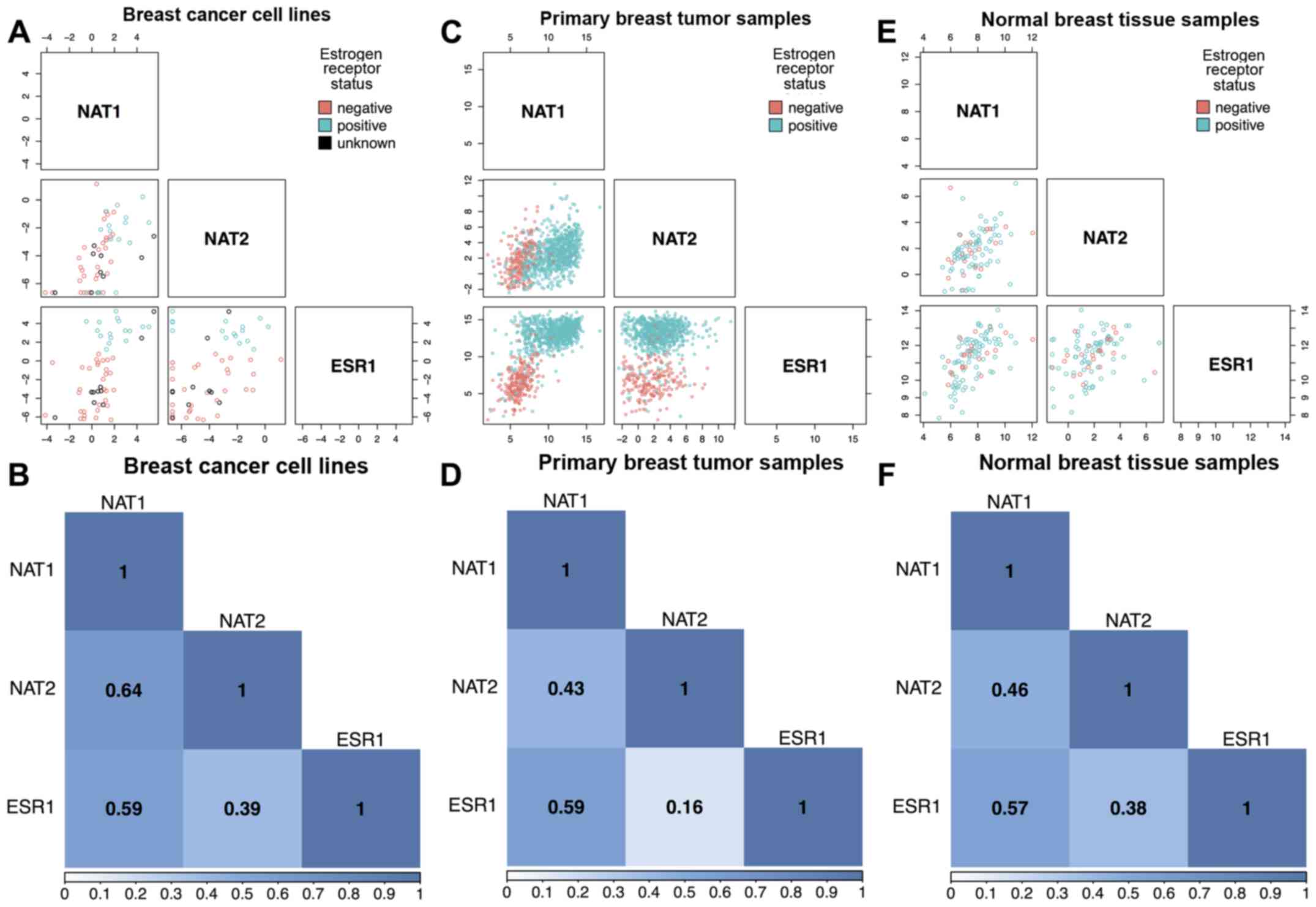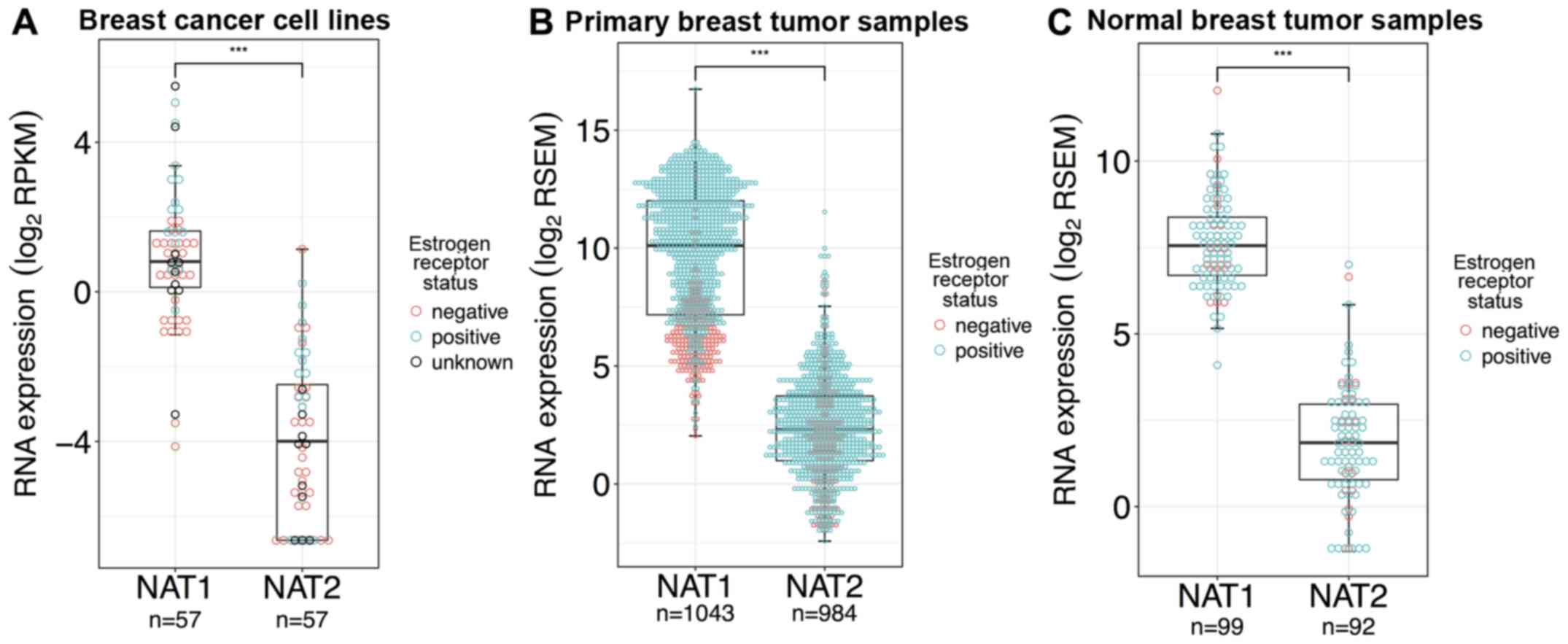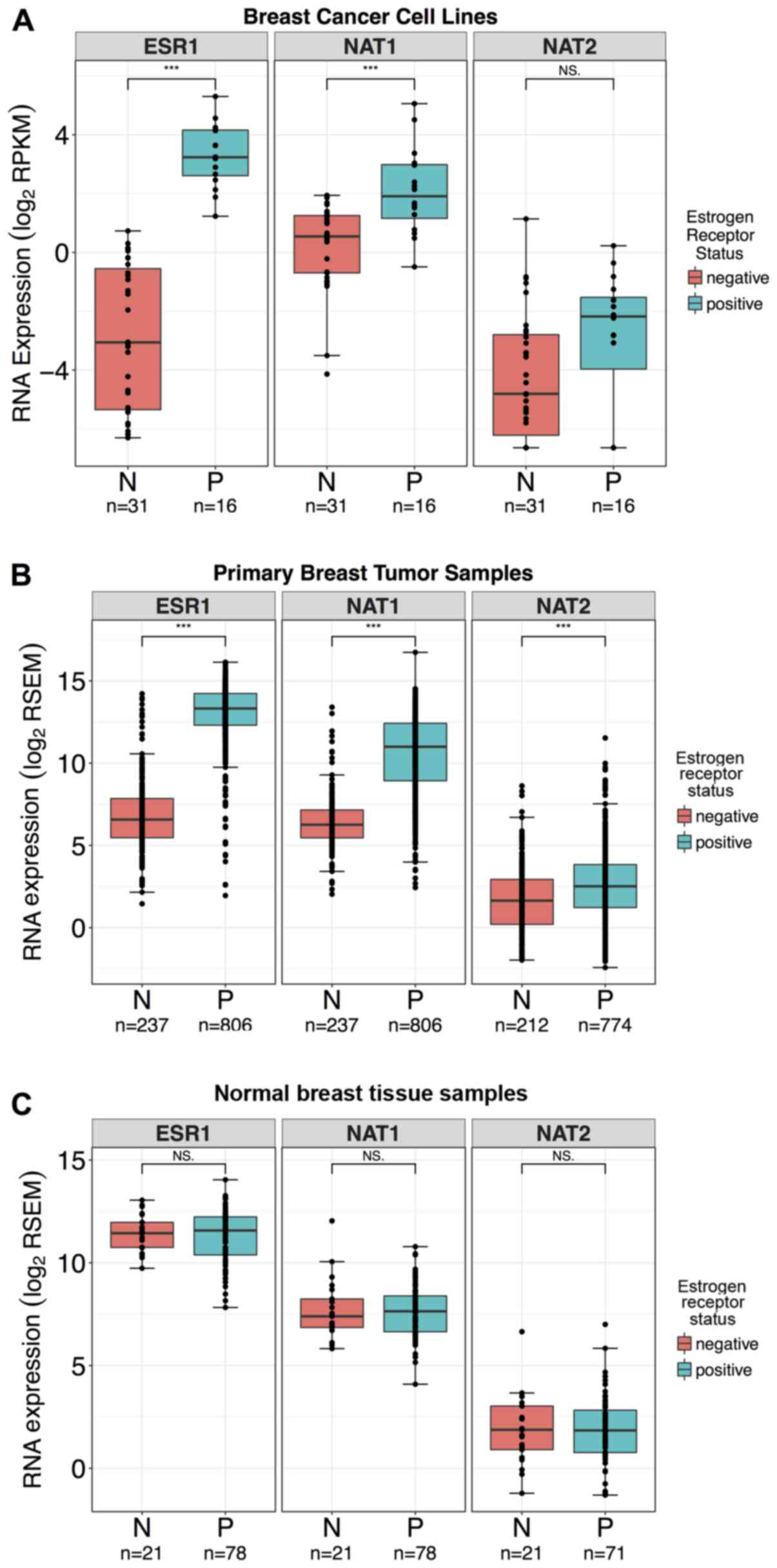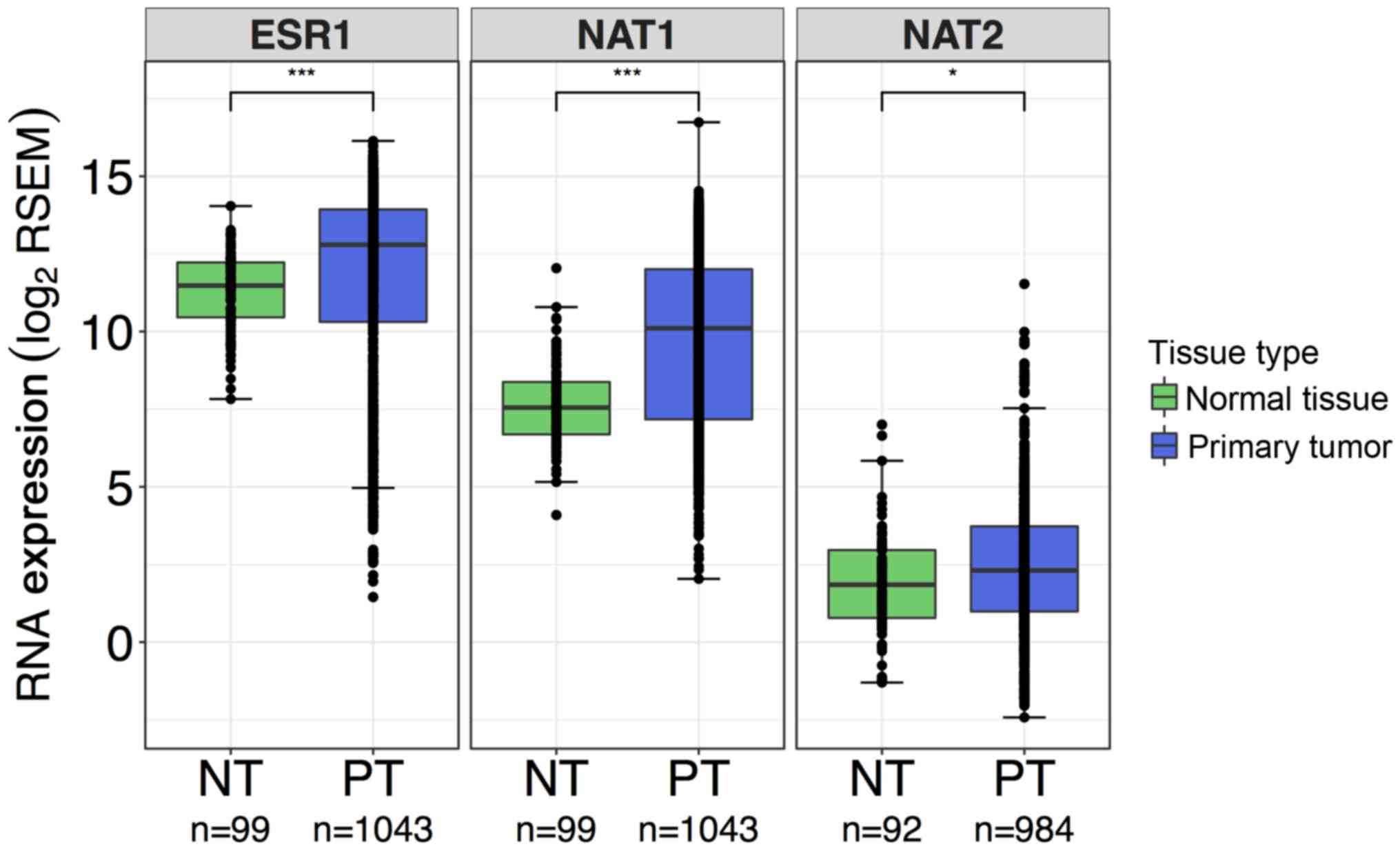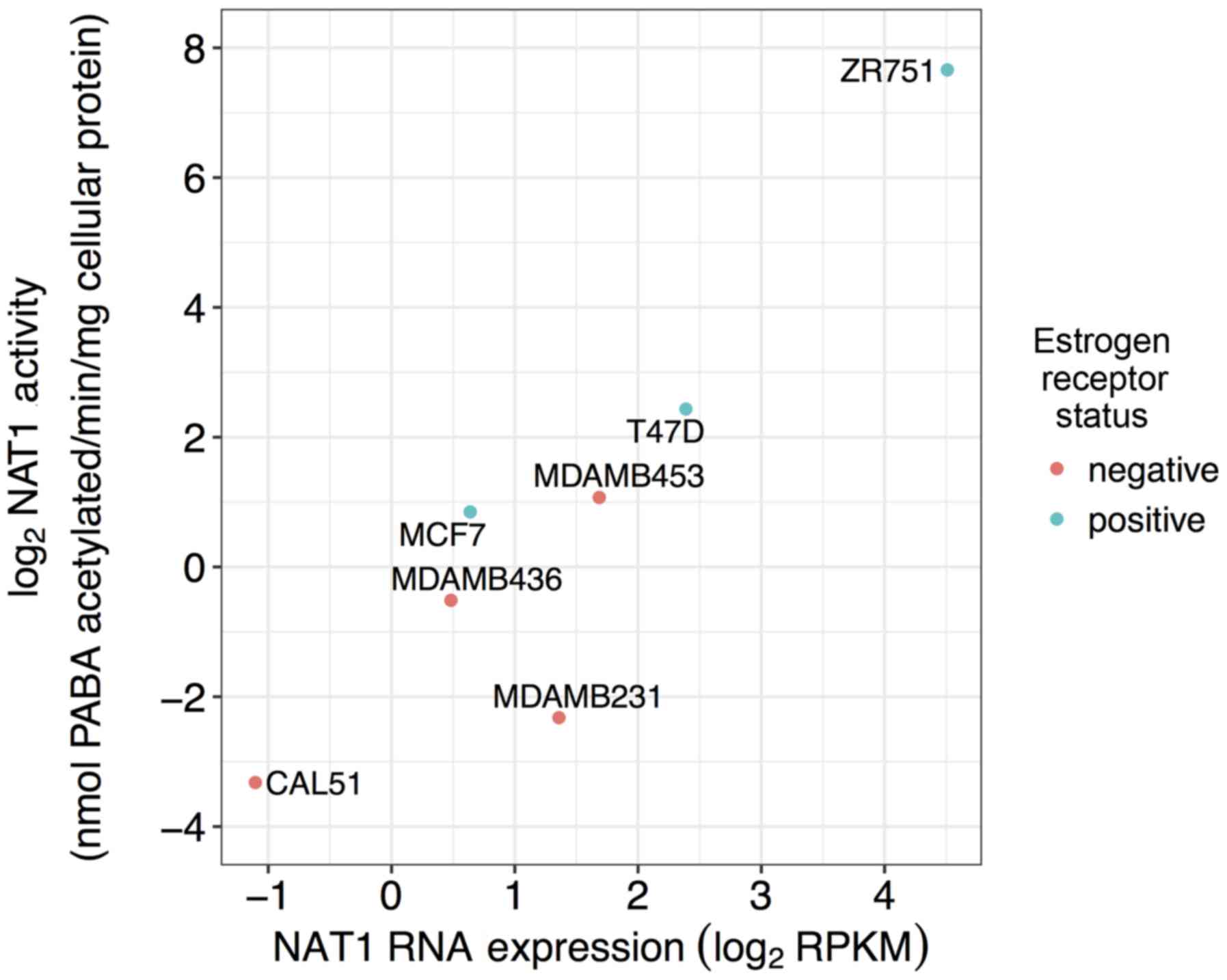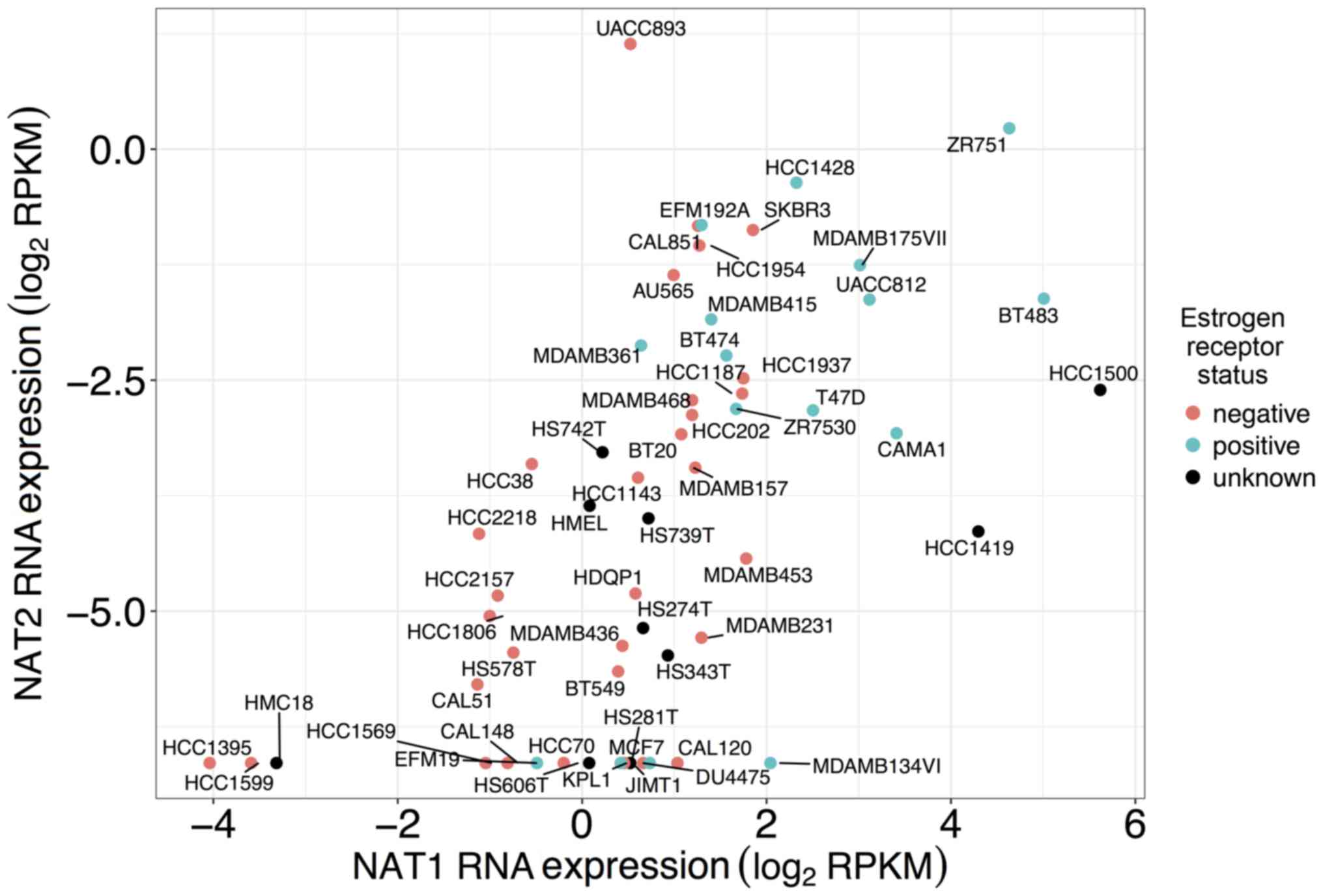|
1
|
Hein DW: Molecular genetics and function
of NAT1 and NAT2: Role in aromatic amine metabolism and
carcinogenesis. Mutat Res. 506–507. 65–77. 2002.
|
|
2
|
Hein DW, Doll MA, Fretland AJ, Leff MA,
Webb SJ, Xiao GH, Devanaboyina US, Nangju NA and Feng Y: Molecular
genetics and epidemiology of the NAT1 and NAT2 acetylation
polymorphisms. Cancer Epidemiol Biomarkers Prev. 9:29–42. 2000.
|
|
3
|
Bendaly J, Zhao S, Neale JR, Metry KJ,
Doll MA, States JC, Pierce WM Jr and Hein DW:
2-Amino-3,8-dimethylimidazo-[4,5-f]quinoxaline-induced DNA adduct
formation and mutagenesis in DNA repair-deficient Chinese hamster
ovary cells expressing human cytochrome 4501A1 and rapid or slow
acetylator N-acetyltransferase 2. Cancer Epidemiol Biomarkers Prev.
16:1503–1509. 2007. View Article : Google Scholar
|
|
4
|
Millner LM, Doll MA, Cai J, States JC and
Hein DW: NATb/NAT1*4 promotes greater arylamine
N-acetyltransferase 1 mediated DNA adducts and mutations than
NATa/NAT1*4 following exposure to 4-aminobiphenyl. Mol
Carcinog. 51:636–646. 2012. View Article : Google Scholar
|
|
5
|
Hein DW: Acetylator genotype and
arylamine-induced carcinogenesis. Biochim Biophys Acta. 948:37–66.
1988.
|
|
6
|
Stepp MW, Mamaliga G, Doll MA, States JC
and Hein DW: Folate-dependent hydrolysis of acetyl-Coenzyme A by
recombinant human and rodent arylamine N-acetyltransferases.
Biochem Biophys Rep. 3:45–50. 2015.
|
|
7
|
Laurieri N, Dairou J, Egleton JE, Stanley
LA, Russell AJ, Dupret JM, Sim E and Rodrigues-Lima F: From
arylamine N-acetyltransferase to folate-dependent acetyl CoA
hydrolase: Impact of folic acid on the activity of (HUMAN)NAT1 and
its homologue (MOUSE)NAT2. PLoS One. 9:e963702014. View Article : Google Scholar
|
|
8
|
Matas N, Thygesen P, Stacey M, Risch A and
Sim E: Mapping AAC1, AAC2 and AACP, the genes for arylamine
N-acetyltransferases, carcinogen metabolising enzymes on human
chromosome 8p22, a region frequently deleted in tumours. Cytogenet
Cell Genet. 77:290–295. 1997. View Article : Google Scholar
|
|
9
|
Hickman D, Risch A, Buckle V, Spurr NK,
Jeremiah SJ, McCarthy A and Sim E: Chromosomal localization of
human genes for arylamine N-acetyltransferase. Biochem J.
297:441–445. 1994. View Article : Google Scholar
|
|
10
|
Grant DM, Blum M, Demierre A and Meyer UA:
Nucleotide sequence of an intronless gene for a human arylamine
N-acetyltransferase related to polymorphic drug acetylation.
Nucleic Acids Res. 17:39781989. View Article : Google Scholar
|
|
11
|
Kawamura A, Graham J, Mushtaq A,
Tsiftsoglou SA, Vath GM, Hanna PE, Wagner CR and Sim E: Eukaryotic
arylamine N-acetyltransferase. Investigation of substrate
specificity by high-throughput screening. Biochem Pharmacol.
69:347–359. 2005. View Article : Google Scholar
|
|
12
|
Vatsis KP and Weber WW: Structural
heterogeneity of Caucasian N-acetyltransferase at the NAT1 gene
locus. Arch Biochem Biophys. 301:71–76. 1993. View Article : Google Scholar
|
|
13
|
Weber WW and Vatsis KP: Individual
variability in p-aminobenzoic acid N-acetylation by human
N-acetyltransferase (NAT1) of peripheral blood. Pharmacogenetics.
3:209–212. 1993. View Article : Google Scholar
|
|
14
|
Grant DM, Hughes NC, Janezic SA,
Goodfellow GH, Chen HJ, Gaedigk A, Yu VL and Grewal R: Human
acetyltransferase polymorphisms. Mutat Res. 376:61–70. 1997.
View Article : Google Scholar
|
|
15
|
Cloete R, Akurugu WA, Werely CJ, van
Helden PD and Christoffels A: Structural and functional effects of
nucleotide variation on the human TB drug metabolizing enzyme
arylamine N-acetyltransferase 1. J Mol Graph Model. 75:330–339.
2017. View Article : Google Scholar
|
|
16
|
McDonagh EM, Boukouvala S, Aklillu E, Hein
DW, Altman RB and Klein TE: PharmGKB summary: Very important
pharmacogene information for N-acetyltransferase 2. Pharmacogenet
Genomics. 24:409–425. 2014.
|
|
17
|
Butcher NJ, Boukouvala S, Sim E and
Minchin RF: Pharmacogenetics of the arylamine N-acetyltransferases.
Pharmacogenomics J. 2:30–42. 2002. View Article : Google Scholar
|
|
18
|
Tiang JM, Butcher NJ and Minchin RF:
Effects of human arylamine N-acetyltransferase I knockdown in
triple-negative breast cancer cell lines. Cancer Med. 4:565–574.
2015. View Article : Google Scholar
|
|
19
|
Tiang JM, Butcher NJ, Cullinane C, Humbert
PO and Minchin RF: RNAi-mediated knock-down of arylamine
N-acetyltransferase-1 expression induces E-cadherin up-regulation
and cell-cell contact growth inhibition. PLoS One. 6:e170312011.
View Article : Google Scholar
|
|
20
|
Tiang JM, Butcher NJ and Minchin RF: Small
molecule inhibition of arylamine N-acetyltransferase Type I
inhibits proliferation and invasiveness of MDA-MB-231 breast cancer
cells. Biochem Biophys Res Commun. 393:95–100. 2010. View Article : Google Scholar
|
|
21
|
Stepp MW, Doll MA, Carlisle SM, States JC
and Hein DW: Genetic and small molecule inhibition of arylamine
N-acetyltransferase 1 reduces anchorage-independent growth in human
breast cancer cell line MDA-MB-231. Mol Carcinog. 57:549–558. 2018.
View Article : Google Scholar
|
|
22
|
Stepp MW, Doll MA, Samuelson DJ, Sanders
MA, States JC and Hein DW: Congenic rats with higher arylamine
N-acetyltransferase 2 activity exhibit greater carcinogen-induced
mammary tumor susceptibility independent of carcinogen metabolism.
BMC Cancer. 17:2332017. View Article : Google Scholar
|
|
23
|
Carlisle SM, Trainor PJ, Yin X, Doll MA,
Stepp MW, States JC, Zhang X and Hein DW: Untargeted polar
metabolomics of transformed MDA-MB-231 breast cancer cells
expressing varying levels of human arylamine N-acetyltransferase 1.
Metabolomics. 12:1112016. View Article : Google Scholar
|
|
24
|
Witham KL, Minchin RF and Butcher NJ: Role
for human arylamine N-acetyltransferase 1 in the methionine salvage
pathway. Biochem Pharmacol. 125:93–100. 2017. View Article : Google Scholar
|
|
25
|
Perou CM, Jeffrey SS, van de Rijn M, Rees
CA, Eisen MB, Ross DT, Pergamenschikov A, Williams CF, Zhu SX and
Lee JC: Distinctive gene expression patterns in human mammary
epithelial cells and breast cancers. Proc Natl Acad Sci USA.
96:9212–9217. 1999. View Article : Google Scholar
|
|
26
|
Zhao H, Langerød A, Ji Y, Nowels KW,
Nesland JM, Tibshirani R, Bukholm IK, Kåresen R, Botstein D and
Børresen-Dale AL: Different gene expression patterns in invasive
lobular and ductal carcinomas of the breast. Mol Biol Cell.
15:2523–2536. 2004. View Article : Google Scholar
|
|
27
|
Wang Y, Klijn JG, Zhang Y, Sieuwerts AM,
Look MP, Yang F, Talantov D, Timmermans M, Meijer-van Gelder ME and
Yu J: Gene-expression profiles to predict distant metastasis of
lymph-node-negative primary breast cancer. Lancet. 365:671–679.
2005. View Article : Google Scholar
|
|
28
|
Wakefield L, Robinson J, Long H, Ibbitt
JC, Cooke S, Hurst HC and Sim E: Arylamine N-acetyltransferase 1
expression in breast cancer cell lines: A potential marker in
estrogen receptor-positive tumors. Genes Chromosomes Cancer.
47:118–126. 2008. View Article : Google Scholar
|
|
29
|
Tozlu S, Girault I, Vacher S, Vendrell J,
Andrieu C, Spyratos F, Cohen P, Lidereau R and Bieche I:
Identification of novel genes that co-cluster with estrogen
receptor alpha in breast tumor biopsy specimens, using a
large-scale real-time reverse transcription-PCR approach. Endocr
Relat Cancer. 13:1109–1120. 2006. View Article : Google Scholar
|
|
30
|
Abba MC, Hu Y, Sun H, Drake JA, Gaddis S,
Baggerly K, Sahin A and Aldaz CM: Gene expression signature of
estrogen receptor alpha status in breast cancer. BMC Genomics.
6:372005. View Article : Google Scholar
|
|
31
|
Bièche I, Girault I, Urbain E, Tozlu S and
Lidereau R: Relationship between intratumoral expression of genes
coding for xenobiotic-metabolizing enzymes and benefit from
adjuvant tamoxifen in estrogen receptor alpha-positive
postmenopausal breast carcinoma. Breast Cancer Res. 6:R252–R263.
2004. View
Article : Google Scholar
|
|
32
|
Zhang X, Carlisle SM, Doll MA, Martin RCG,
States JC, Klinge CM and Hein DW: High N-acetyltransferase 1
expression is associated with estrogen receptor expression in
breast tumors, but is not under direct regulation by estradiol,
5α-androstane-3β,17β-diol, or dihydrotestosterone in breast cancer
cells. J Pharmacol Exp Ther. 365:84–93. 2018. View Article : Google Scholar
|
|
33
|
Ambrosone CB, Kropp S, Yang J, Yao S,
Shields PG and Chang-Claude J: Cigarette smoking,
N-acetyltransferase 2 genotypes, and breast cancer risk: Pooled
analysis and meta-analysis. Cancer Epidemiol Biomarkers Prev.
17:15–26. 2008. View Article : Google Scholar
|
|
34
|
Sadrieh N, Davis CD and Snyderwine EG:
N-acetyltransferase expression and metabolic activation of the
food-derived heterocyclic amines in the human mammary gland. Cancer
Res. 56:2683–2687. 1996.
|
|
35
|
Husain A, Zhang X, Doll MA, States JC,
Barker DF and Hein DW: Identification of N-acetyltransferase 2
(NAT2) transcription start sites and quantitation of NAT2-specific
mRNA in human tissues. Drug Metab Dispos. 35:721–727. 2007.
View Article : Google Scholar
|
|
36
|
Lee JH, Chung JG, Lai JM, Levy GN and
Weber WW: Kinetics of arylamine N-acetyltransferase in tissues from
human breast cancer. Cancer Lett. 111:39–50. 1997. View Article : Google Scholar
|
|
37
|
Husain A, Barker DF, States JC, Doll MA
and Hein DW: Identification of the major promoter and non-coding
exons of the human arylamine N-acetyltransferase 1 gene (NAT1).
Pharmacogenetics. 14:397–406. 2004. View Article : Google Scholar
|
|
38
|
Geylan YS, Dizbay S and Güray T: Arylamine
N-acetyltransferase activities in human breast cancer tissues.
Neoplasma. 48:108–111. 2001.
|
|
39
|
Geylan-Su YS, Isgör B, Coban T, Kapucuoglu
N, Aydintug S, Iscan M, Iscan M and Güray T: Comparison of NAT1,
NAT2 and GSTT2-2 activities in normal and neoplastic human breast
tissues. Neoplasma. 53:73–78. 2006.
|
|
40
|
Deitz AC: N-acetyltransferase genetic
polymorphisms and breast cancer risk. In: PhD dissertation.
University of North Dakota; 1999
|
|
41
|
Jefferson FA, Xiao GH and Hein DW:
4-Aminobiphenyl downregulation of NAT2 acetylator
genotype-dependent N- and O-acetylation of aromatic and
heterocyclic amine carcinogens in primary mammary epithelial cell
cultures from rapid and slow acetylator rats. Toxicol Sci.
107:293–297. 2009. View Article : Google Scholar
|
|
42
|
Bradshaw TD, Chua MS, Orr S, Matthews CS
and Stevens MF: Mechanisms of acquired resistance to
2-(4-aminophenyl)benzothiazole (CJM 126, NSC 34445). Br J Cancer.
83:270–277. 2000. View Article : Google Scholar
|
|
43
|
Barretina J, Caponigro G, Stransky N,
Venkatesan K, Margolin AA, Kim S, Wilson CJ, Lehár J, Kryukov GV
and Sonkin D: The Cancer Cell Line Encyclopedia enables predictive
modelling of anticancer drug sensitivity. Nature. 483:603–607.
2012. View Article : Google Scholar
|
|
44
|
Weinstein JN, Collisson EA, Mills GB, Shaw
KR, Ozenberger BA, Ellrott K, Shmulevich I, Sander C and Stuart JM;
Cancer Genome Atlas Research Network: The Cancer Genome Atlas
Pan-Cancer analysis project. Nat Genet. 45:1113–1120. 2013.
View Article : Google Scholar
|
|
45
|
Deng M, Bragelmann J, Kryukov I,
Saraiva-Agostinho N and Perner S: FirebrowseR: an R client to the
Broad Institute’s Firehose Pipeline. Database (Oxford) 2017.
baw1602017. View Article : Google Scholar
|
|
46
|
Dai X, Cheng H, Bai Z and Li J: Breast
cancer cell line classification and its relevance with breast tumor
subtyping. J Cancer. 8:3131–3141. 2017. View Article : Google Scholar
|
|
47
|
American Type Culture Collection (ATCC©):
Breast cancer and normal cell lines. 2013, https://www.atcc.org/~/media/PDFs/Cancer%20and%20Normal%20cell%20lines%20tables/Breast%20cancer%20and%20normal%20cell%20lines.ashx.
Accessed Feb 2, 2018.
|
|
48
|
Kao J, Salari K, Bocanegra M, Choi YL,
Girard L, Gandhi J, Kwei KA, Hernandez-Boussard T, Wang P, Gazdar
AF, et al: Molecular profiling of breast cancer cell lines defines
relevant tumor models and provides a resource for cancer gene
discovery. PLoS One. 4:e61462009. View Article : Google Scholar
|
|
49
|
R Core Team: R: A language and environment
for statistical computing. R Foundation for Statistical Computing;
Vienna, Austria: 2017, http://www.R-project.org/.
Accessed Dec 15, 2017.
|
|
50
|
Capes-Davis A, Theodosopoulos G, Atkin I,
Drexler HG, Kohara A, MacLeod RA, Masters JR, Nakamura Y, Reid YA
and Reddel RR: Check your cultures! A list of cross-contaminated or
misidentified cell lines. Int J Cancer. 127:1–8. 2010. View Article : Google Scholar
|
|
51
|
Thorpe SM: Estrogen and progesterone
receptor determinations in breast cancer. Technology, biology and
clinical significance Acta Oncol. 27:1–19. 1988.
|
|
52
|
Williams JA, Stone EM, Fakis G, Johnson N,
Cordell JA, Meinl W, Glatt H, Sim E and Phillips DH:
N-Acetyltransferases, sulfotransferases and heterocyclic amine
activation in the breast. Pharmacogenetics. 11:373–388. 2001.
View Article : Google Scholar
|
|
53
|
AbuHammad S and Zihlif M: Gene expression
alterations in doxorubicin resistant MCF7 breast cancer cell line.
Genomics. 101:213–220. 2013. View Article : Google Scholar
|
|
54
|
Hein DW: N-acetyltransferase 2
polymorphism and human urinary bladder and breast cancer risks.
Arylamine N-Acetyltransferases in Health and Disease: From
Pharmacogenetics to Drug Discovery and Diagnostics. Laurieri N and
Sim E: World Scientific Publishing; Singapore: pp. 327–349. 2018,
View Article : Google Scholar
|
|
55
|
Butcher NJ and Minchin RF: Arylamine
N-acetyltransferase 1: A novel drug target in cancer development.
Pharmacol Rev. 64:147–165. 2012. View Article : Google Scholar
|
|
56
|
Laurieri N, Egleton JE and Russell AJ:
Human N-acetyltransferase type 1 and breast cancer. Arylamine
N-Acetyltransferases in Health and Disease: From Pharmacogenetics
to Drug Discovery and Diagnostics. Laurieri N and Sim E: World
Scientific Publishing; Singapore: pp. 351–384. 2018, View Article : Google Scholar
|



